Pork Adobo wasn't just a dish, it was my culinary coming-of-age story. This was the very first recipe I learned from my Lola, standing on a tiny stool in her kitchen, mesmerized by how she transformed simple ingredients into what would become my family's most requested dish.
She'd always tell me with a knowing smile, wasn't just in the perfect balance of toyo and suka, but in the patience of letting the pork belly simmer until it's melt-in-your-mouth tender.
Today, whether I'm cooking it for a simple family dinner or bringing it to a potluck (where it's always the first to disappear), this recipe has never failed me.
The beauty of adobo is how it gets even better the next day.
I'm excited to share my family's treasured version of this Filipino classic with you, complete with all the little tricks I've learned over countless dinners and celebrations.
Jump to:
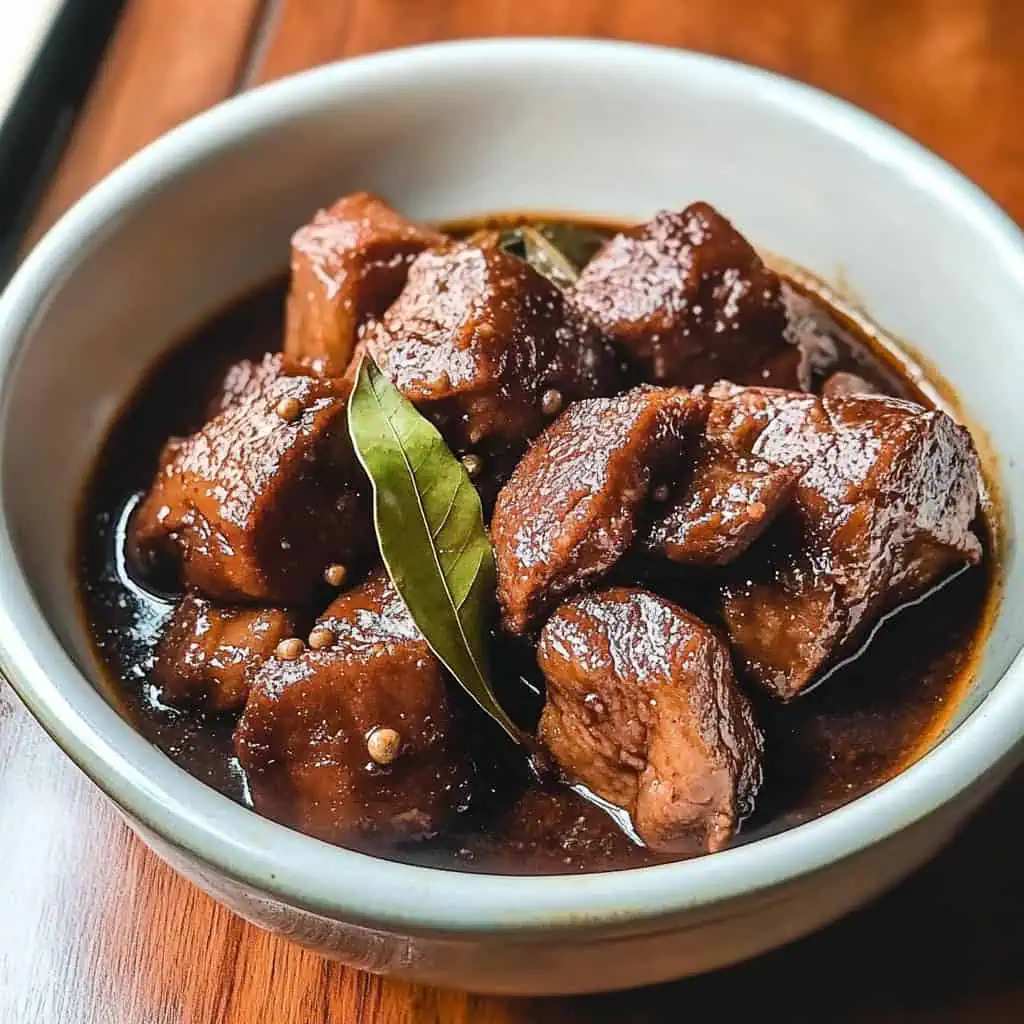
Why You'll Love This Recipe
- Rich in Tradition: Experience the Philippines' most beloved dish, perfected through generations
- Complex Flavors: Perfect balance of savory (alat), sour (asim), and umami notes
- Make-Ahead Friendly: Tastes even better the next day
- One-Pot Wonder: Minimal cleanup required
- Versatile: Can be served for casual family dinners or special occasions
- Beginner-Friendly: Simple techniques with impressive results
Ingredients
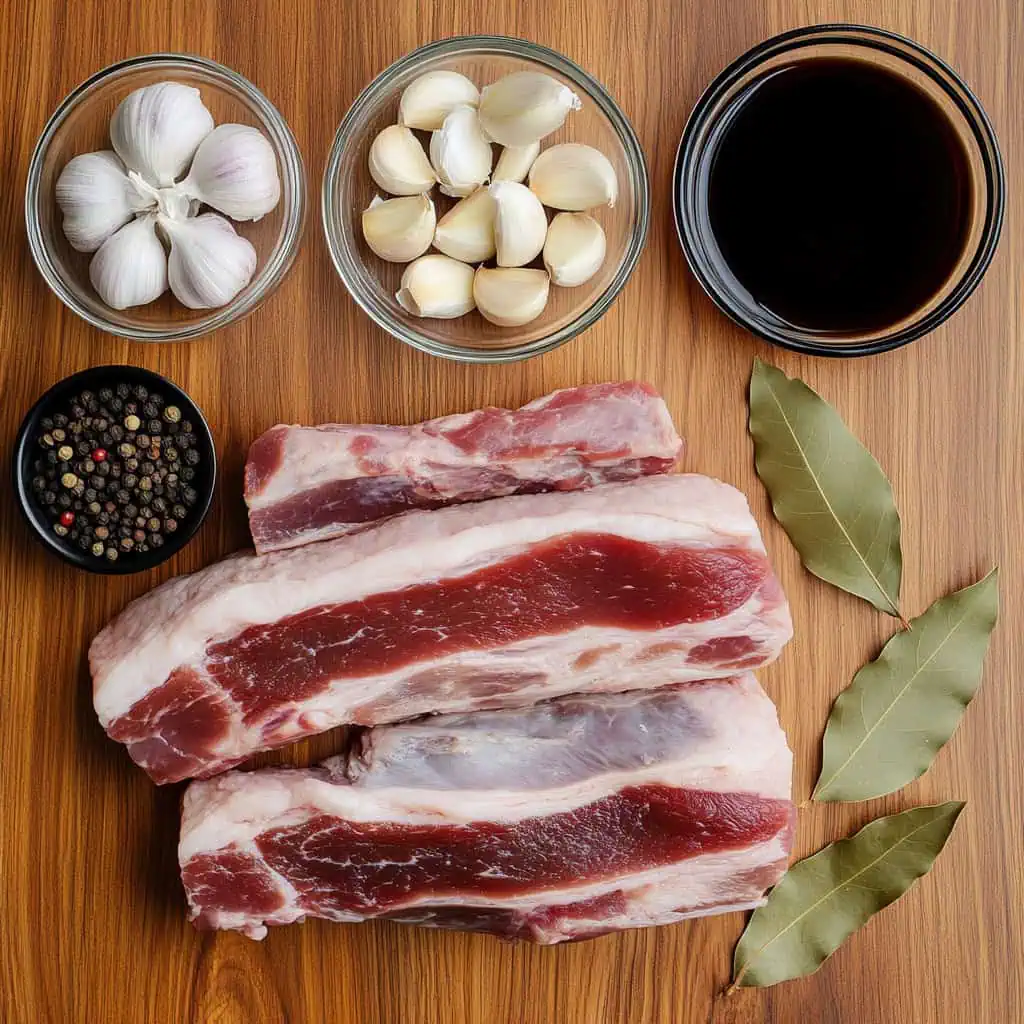
- 2 lbs pork belly, cut into 2-inch chunks
- ½ cup soy sauce
- 2 whole heads garlic, crushed
- 5 dried bay leaves
- 4 tablespoons white vinegar
- 1 tablespoon whole black peppercorns
- 2 cups water
- Salt to taste
Optional Enhancements
- 1 medium onion, chopped
- 1 teaspoon brown sugar
- 2-3 Thai chilies for heat
- 4 medium potatoes, quartered
Equipment
- Large heavy-bottom pot or Dutch oven: For even heat distribution and preventing burning of the sauce
- Sharp knife: For cutting meat into consistent chunks to ensure even cooking
- Measuring cups and spoons: For accurate ingredient portioning
- Mortar and pestle: For crushing garlic and peppercorns to release their essential oils
- Tongs: For turning meat without piercing it and losing juices
- Marinating container: Glass or non-reactive container that won't react with acidic ingredients
- Wooden spoon: For stirring without scratching the pot and preserving its longevity
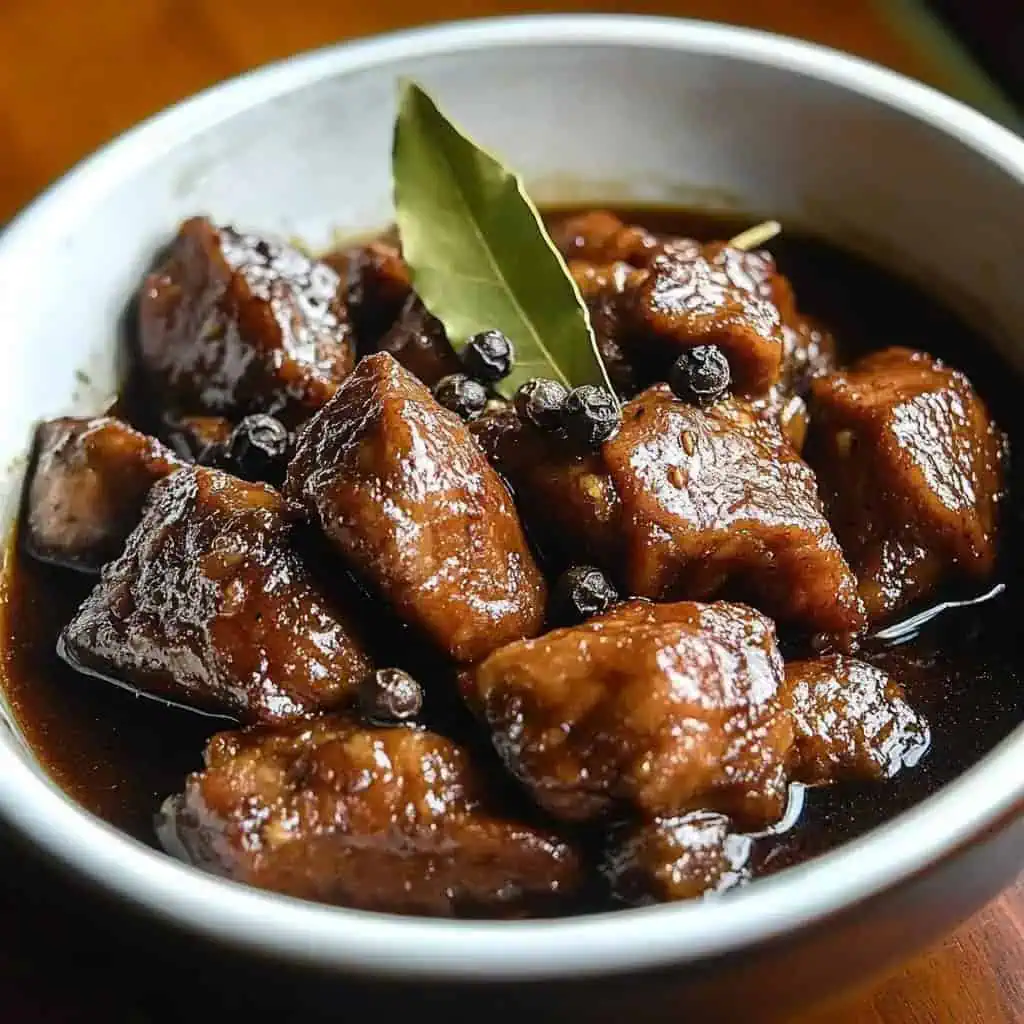
How To Make
- Cut your pork belly into 2-inch chunks. Place the meat in a bowl and mix it with soy sauce and crushed garlic. Let this marinate in the refrigerator for at least 1 hour.
- Heat your pot over medium-high heat (350°F/175°C). Once hot, put in your marinated pork along with all the marinade. Cook for about 5 minutes until the meat starts to brown slightly.
- Pour in 2 cups of water. Add your whole peppercorns and dried bay leaves. Wait for it to boil, then lower the heat to medium-low (300°F/150°C). Cover the pot and let it simmer for 40 minutes, checking occasionally to make sure there's enough liquid.
- Add the vinegar to your pot. Here's an important tip: don't stir it right away. Let it simmer quietly for 3 minutes first – this keeps the vinegar from becoming bitter. After waiting, you can give everything a gentle stir.
- Let everything cook together for another 12-15 minutes with the lid off. This helps the sauce become richer and thicker. If you want less sauce, cook it a bit longer.
- Taste the sauce and add a little salt if needed. Once you're happy with the taste, turn off the heat and let your adobo rest for 5 minutes.
- Your pork adobo is now ready to serve. Put it in a bowl and serve hot with plenty of steamed rice. Don't forget to spoon some of that flavorful sauce over your rice.

Tips from Lola's Kitchen
- Meat Selection: Choose pork belly with a good meat-to-fat ratio (70:30) for the perfect balance of flavor and texture. The fat will render during cooking, creating a luscious sauce.
- Vinegar Rule: Never stir immediately after adding vinegar to prevent it from becoming bitter. Let it cook undisturbed for at least 3 minutes to preserve its bright flavor.
- Garlic Wisdom: Crush garlic cloves instead of mincing them to release more aromatic oils and create a deeper flavor base.
- Marination Secret: Score the meat's surface before marinating to allow better flavor absorption and more tender results.
- The Simmer Method: A gentle, slow simmer is crucial for developing depth of flavor and achieving that signature melt-in-your-mouth texture.
- Final Rest: Always allow your adobo to rest for 5-10 minutes before serving to let the flavors settle and meat fibers relax.
- Leftover Magic: If you can resist eating it all immediately, save some for the next day when the flavors will have intensified beautifully.
Substitutions
- Meat Alternatives: Substitute pork shoulder for a leaner option, or use chicken thighs for adobong manok (reduce cooking time to 30-40 minutes).
- Vinegar Options: White vinegar can be replaced with cane vinegar for a milder taste or apple cider vinegar for a slightly fruity note.
- Soy Sauce Alternatives: Use liquid aminos or coconut aminos for a gluten-free version with a slightly different flavor profile.
- Bay Leaf Substitution: Fresh bay leaves can replace dried (use half the amount as they're stronger).
- Peppercorn Options: Ground black pepper can substitute whole peppercorns (use 1.5 teaspoons), though the flavor release will be more immediate.
- Sweetener Options: Brown sugar can be replaced with coconut sugar or honey for different flavor nuances.
Troubleshooting
- Too Salty: Add quartered potatoes to absorb excess salt, incorporate a touch of sugar to balance flavors, or add more water and reduce the sauce again.
- Too Sour: Balance excessive sourness with a pinch of sugar or a bit more soy sauce, or reduce the sauce further to mellow the acidity.
- Tough Meat: Continue simmering on low heat until tender, as some cuts may require longer cooking. Check if your heat was too high, which can toughen meat fibers.
- Watery Sauce: Remove the lid and simmer for an additional 10-15 minutes to reduce and concentrate the flavors.
- Bitter Taste: This usually happens when vinegar is stirred too soon; for your next batch, remember to let it simmer untouched for 3-5 minutes after adding.
- Bland Flavor: Enhance with a splash more soy sauce, additional crushed garlic, or a squeeze of calamansi juice for brightness.
Storage & Reheating
- Refrigerator Storage: Keep in an airtight container for 3-4 days. The flavor actually improves after a day in the fridge!
- Freezer Storage: Freeze for up to 3 months in freezer-safe containers. Always let cool completely before storing.
- Stovetop Reheating: Reheat gently over low heat with a splash of water to loosen the sauce. This method preserves the texture best.
- Microwave Reheating: Use 70% power and stir halfway through to avoid overheating certain portions.
- Flavor Enhancement: Add a fresh bay leaf or crack of black pepper when reheating to reinvigorate the flavors.
- Crispy Variation: For a delicious twist, try reheating in a pan until the edges crisp up slightly for textural contrast.
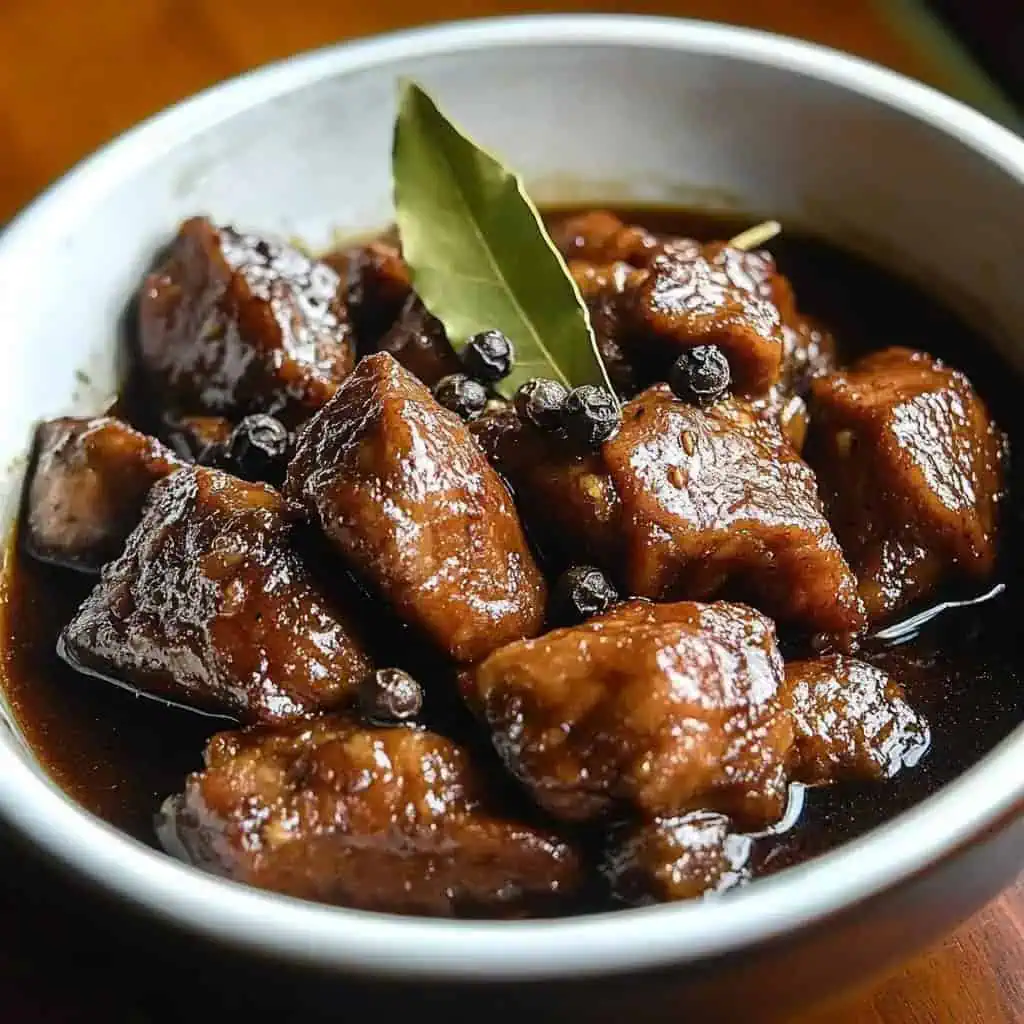
FAQ
Can I reduce marination time?
While minimum 1 hour works, 3-4 hours is ideal for best flavor development. For maximum flavor, consider marinating overnight.
Why did my adobo turn bitter?
Most likely you stirred the vinegar too soon after adding. Always let it simmer untouched for 3-5 minutes to prevent bitterness.
Can I make this in advance for a party?
Absolutely! The flavor improves overnight, making it an excellent make-ahead dish. Refrigerate and reheat when needed.
How do I know when the pork is done?
The meat should be fork-tender and easily pulled apart. If it's still tough, continue simmering until it reaches the desired tenderness.
Is this recipe freezer-friendly?
Yes, it freezes beautifully for up to 3 months. The flavors remain intact and sometimes even improve after freezing.
Can I use a slow cooker for this recipe?
Definitely! Brown the meat first, then cook on low for 6-8 hours for incredibly tender results.
How can I make this healthier?
Use leaner pork cuts like tenderloin or loin, reduce the amount of soy sauce, and skim excess fat after cooking.
What sides pair well with adobo?
Traditional sides include steamed rice, pickled green papaya (atchara), fresh tomato and onion salad, or sautéed water spinach (kangkong).
Related
Looking for other recipes like this? Try these:
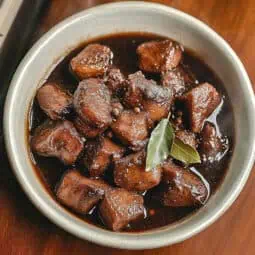
Filipino Pork Adobo (Adobong Baboy)
Equipment
- Large heavy-bottom pot or Dutch oven (kaldero) For even heat distribution
- Sharp knife (kutsilyo) For cutting meat
- Measuring cups and spoons (Panukat) For accurate portioning
- Mortar and pestle (dikdikan) For crushing garlic and peppercorns
- Tongs [Sipit] For turning meat
- Marinating container (lalagyan) Glass or non-reactive container
- Wooden spoon (sandok na kahoy) For stirring without scratching the pot
Ingredients
For the Main Dish:
- 2 lbs pork belly liempo, cut into 2-inch chunks
- ½ cup soy sauce toyo
- 2 whole heads garlic bawang, crushed
- 5 dried bay leaves dahon ng laurel
- 4 tablespoons white vinegar suka
- 1 tablespoon whole black peppercorns paminta
- 2 cups water tubig
- Salt asin to taste
Optional Enhancements:
- 1 medium onion sibuyas, chopped
- 1 teaspoon brown sugar asukal na pula
- 2-3 Thai chilies siling labuyo for heat
- 4 medium potatoes patatas, quartered
Instructions
- Cut your pork belly into 2-inch chunks. Place the meat in a bowl and mix it with soy sauce and crushed garlic. Let this marinate in the refrigerator for at least 1 hour.
- Heat your pot over medium-high heat (350°F/175°C). Once hot, put in your marinated pork along with all the marinade. Cook for about 5 minutes until the meat starts to brown slightly.
- Pour in 2 cups of water. Add your whole peppercorns and dried bay leaves. Wait for it to boil, then lower the heat to medium-low (300°F/150°C). Cover the pot and let it simmer for 40 minutes, checking occasionally to make sure there's enough liquid.
- Add the vinegar to your pot. Here's an important tip: don't stir it right away. Let it simmer quietly for 3 minutes first – this keeps the vinegar from becoming bitter. After waiting, you can give everything a gentle stir.
- Let everything cook together for another 12-15 minutes with the lid off. This helps the sauce become richer and thicker. If you want less sauce, cook it a bit longer.
- Taste the sauce and add a little salt if needed. Once you're happy with the taste, turn off the heat and let your adobo rest for 5 minutes.
- Your pork adobo is now ready to serve. Put it in a bowl and serve hot with plenty of steamed rice. Don't forget to spoon some of that flavorful sauce over your rice.
Tips from Lola's Kitchen
- Meat Selection: Choose pork belly with a good meat-to-fat ratio (70:30)
- Vinegar Rule: Never stir immediately after adding vinegar to prevent it from becoming bitter (mapait)
- Garlic Wisdom: Crush, don't mince, for better flavor release
- Marination Secret: Score the meat's surface for better flavor absorption
- Cooking Vessel: Use clay pot (palayok) if available for authentic earthen flavor
Nutrition
The Story Behind Filipino Pork Adobo
Pork Adobo, or Adobong Baboy, stands as a testament to the Philippines' rich culinary heritage, representing more than just a method of cooking – it's a story of Filipino ingenuity and cultural adaptation. While many consider it the unofficial national dish of the Philippines, its origins reveal a fascinating journey through centuries of cultural interchange and culinary evolution.
The term "adobo" comes from the Spanish word "adobar," meaning to marinate or season. However, the cooking method predates Spanish colonization of the Philippines in the 16th century. Our ancestors had already developed this ingenious cooking technique of preserving meat in vinegar and salt, a practical solution for keeping food fresh in the tropical Philippine climate before the era of refrigeration.
When the Spanish arrived in 1521, they encountered this cooking method and named it "adobo" due to its similarity to their own marination processes. The Chinese traders who had been visiting the Philippines for centuries before the Spanish had already influenced the recipe – it's believed that soy sauce, now a crucial ingredient in most adobo recipes, was incorporated into the dish through Chinese cultural exchange, replacing or supplementing the traditional salt.
What makes Filipino adobo unique is its use of vinegar as a primary cooking ingredient. The vinegar not only preserved the meat but also helped create that distinctive tangy flavor that millions now associate with comfort and home. Whether using palm vinegar (sukang paombong), cane vinegar (sukang iloko), or coconut vinegar (sukang tuba), each region developed its own version, contributing to the diverse adobo landscape we see today.
In modern Filipino cuisine, pork adobo appears on tables from simple family dinners to elaborate fiestas. Its popularity has spread globally, with food critics and chefs worldwide recognizing it as a masterpiece of Southeast Asian cuisine. The dish has even evolved beyond its traditional preparation, with variations including adobo sa gata (with coconut milk), adobong puti (white adobo without soy sauce), and the trendy adobo flakes.
Perhaps most remarkably, despite its widespread popularity and countless variations, the core of adobo remains unchanged – the perfect harmony of garlic, vinegar, peppercorns, and bay leaves creating a dish that only gets better with time. As Filipinos say, "mas masarap pa kinabukasan" (it tastes even better the next day), a quality that has endeared it to generations of food lovers and made it a symbol of Filipino culinary excellence.
Today, each Filipino family treasures their own adobo recipe, passed down through generations with subtle variations in ingredients and techniques. These family recipes tell stories of regional preferences, personal tastes, and cherished memories gathered around the dinner table. From the northern provinces of Luzon to the southern islands of Mindanao, adobo remains a unifying dish that bridges regional differences and brings Filipino families together.
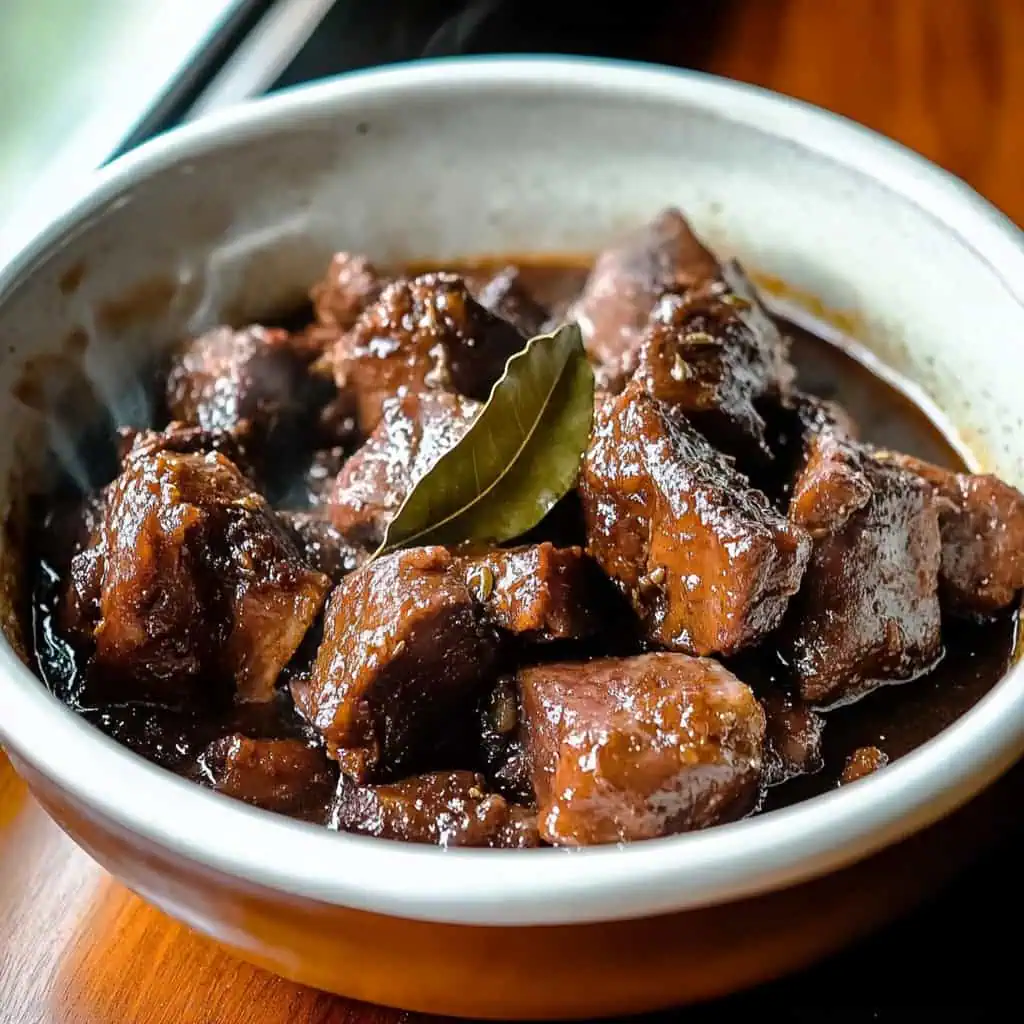









Comments
No Comments